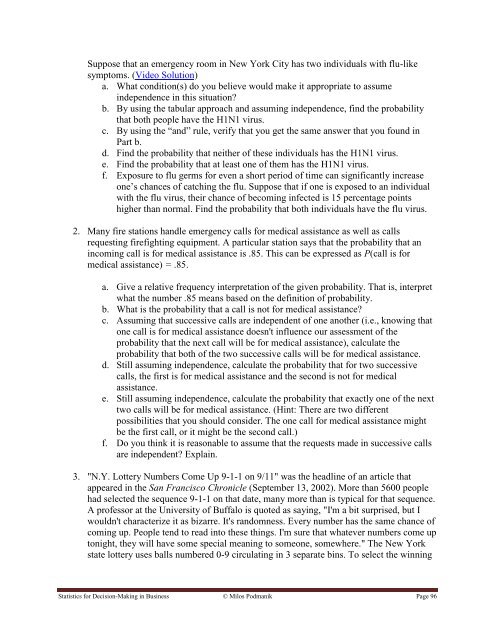Statistics for Decision- Making in Business - Maricopa Community ...
Statistics for Decision- Making in Business - Maricopa Community ...
Statistics for Decision- Making in Business - Maricopa Community ...
Create successful ePaper yourself
Turn your PDF publications into a flip-book with our unique Google optimized e-Paper software.
Suppose that an emergency room <strong>in</strong> New York City has two <strong>in</strong>dividuals with flu-like<br />
symptoms. (Video Solution)<br />
a. What condition(s) do you believe would make it appropriate to assume<br />
<strong>in</strong>dependence <strong>in</strong> this situation<br />
b. By us<strong>in</strong>g the tabular approach and assum<strong>in</strong>g <strong>in</strong>dependence, f<strong>in</strong>d the probability<br />
that both people have the H1N1 virus.<br />
c. By us<strong>in</strong>g the “and” rule, verify that you get the same answer that you found <strong>in</strong><br />
Part b.<br />
d. F<strong>in</strong>d the probability that neither of these <strong>in</strong>dividuals has the H1N1 virus.<br />
e. F<strong>in</strong>d the probability that at least one of them has the H1N1 virus.<br />
f. Exposure to flu germs <strong>for</strong> even a short period of time can significantly <strong>in</strong>crease<br />
one‟s chances of catch<strong>in</strong>g the flu. Suppose that if one is exposed to an <strong>in</strong>dividual<br />
with the flu virus, their chance of becom<strong>in</strong>g <strong>in</strong>fected is 15 percentage po<strong>in</strong>ts<br />
higher than normal. F<strong>in</strong>d the probability that both <strong>in</strong>dividuals have the flu virus.<br />
2. Many fire stations handle emergency calls <strong>for</strong> medical assistance as well as calls<br />
request<strong>in</strong>g firefight<strong>in</strong>g equipment. A particular station says that the probability that an<br />
<strong>in</strong>com<strong>in</strong>g call is <strong>for</strong> medical assistance is .85. This can be expressed as P(call is <strong>for</strong><br />
medical assistance) = .85.<br />
a. Give a relative frequency <strong>in</strong>terpretation of the given probability. That is, <strong>in</strong>terpret<br />
what the number .85 means based on the def<strong>in</strong>ition of probability.<br />
b. What is the probability that a call is not <strong>for</strong> medical assistance<br />
c. Assum<strong>in</strong>g that successive calls are <strong>in</strong>dependent of one another (i.e., know<strong>in</strong>g that<br />
one call is <strong>for</strong> medical assistance doesn't <strong>in</strong>fluence our assessment of the<br />
probability that the next call will be <strong>for</strong> medical assistance), calculate the<br />
probability that both of the two successive calls will be <strong>for</strong> medical assistance.<br />
d. Still assum<strong>in</strong>g <strong>in</strong>dependence, calculate the probability that <strong>for</strong> two successive<br />
calls, the first is <strong>for</strong> medical assistance and the second is not <strong>for</strong> medical<br />
assistance.<br />
e. Still assum<strong>in</strong>g <strong>in</strong>dependence, calculate the probability that exactly one of the next<br />
two calls will be <strong>for</strong> medical assistance. (H<strong>in</strong>t: There are two different<br />
possibilities that you should consider. The one call <strong>for</strong> medical assistance might<br />
be the first call, or it might be the second call.)<br />
f. Do you th<strong>in</strong>k it is reasonable to assume that the requests made <strong>in</strong> successive calls<br />
are <strong>in</strong>dependent Expla<strong>in</strong>.<br />
3. "N.Y. Lottery Numbers Come Up 9-1-1 on 9/11" was the headl<strong>in</strong>e of an article that<br />
appeared <strong>in</strong> the San Francisco Chronicle (September 13, 2002). More than 5600 people<br />
had selected the sequence 9-1-1 on that date, many more than is typical <strong>for</strong> that sequence.<br />
A professor at the University of Buffalo is quoted as say<strong>in</strong>g, "I'm a bit surprised, but I<br />
wouldn't characterize it as bizarre. It's randomness. Every number has the same chance of<br />
com<strong>in</strong>g up. People tend to read <strong>in</strong>to these th<strong>in</strong>gs. I'm sure that whatever numbers come up<br />
tonight, they will have some special mean<strong>in</strong>g to someone, somewhere." The New York<br />
state lottery uses balls numbered 0-9 circulat<strong>in</strong>g <strong>in</strong> 3 separate b<strong>in</strong>s. To select the w<strong>in</strong>n<strong>in</strong>g<br />
<strong>Statistics</strong> <strong>for</strong> <strong>Decision</strong>-<strong>Mak<strong>in</strong>g</strong> <strong>in</strong> Bus<strong>in</strong>ess © Milos Podmanik Page 96
















